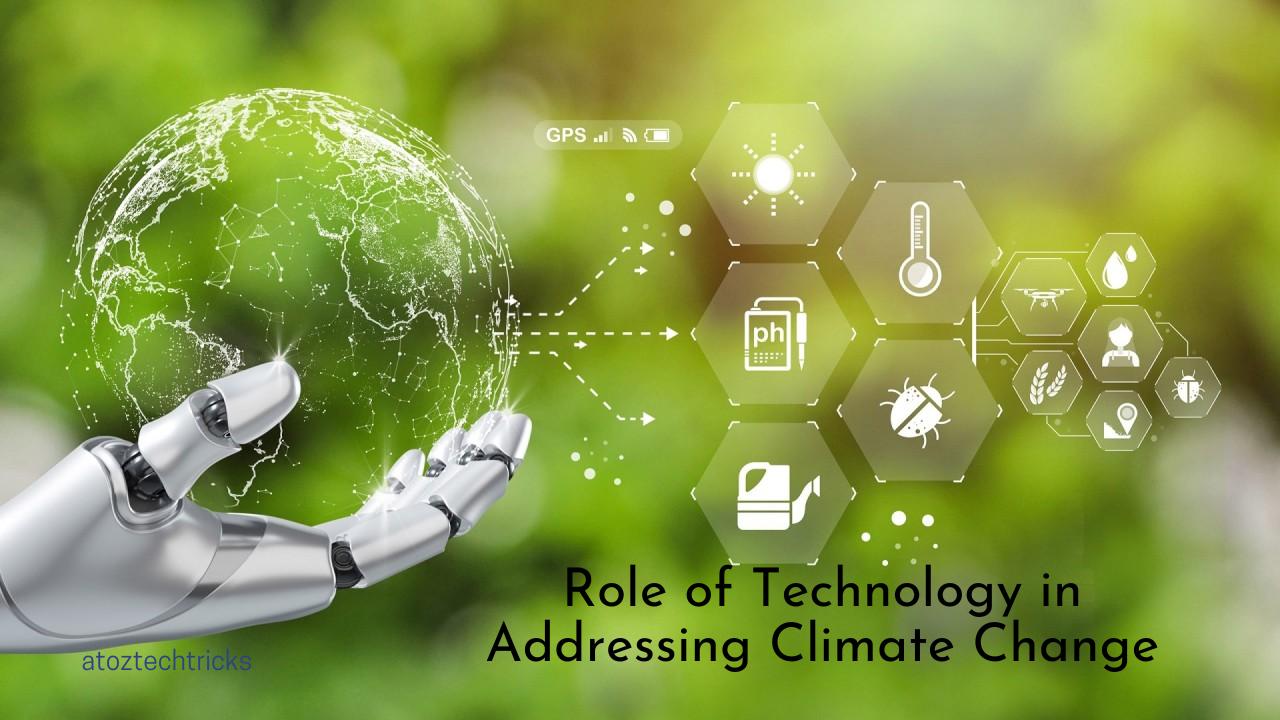Climate change, driven primarily by human activities, poses one of the most significant challenges of our time. The increasing concentrations of greenhouse gases in the atmosphere have led to rising global temperatures, melting ice caps, and more frequent extreme weather events. As the impacts of climate change become ever more apparent, the role of technology in mitigating and adapting to these effects has become increasingly crucial. This comprehensive exploration will delve into the various technological innovations and strategies that are instrumental in addressing climate change, highlighting their benefits, limitations, and prospects.
1. Renewable Energy Technologies
1.1 Solar Power
Solar power is one of the most promising technologies for reducing greenhouse gas emissions. Solar photovoltaic (PV) panels convert sunlight directly into electricity, providing a clean and renewable energy source. Technological advancements have significantly improved the efficiency and affordability of solar panels. For instance, recent innovations in materials, such as perovskite solar cells, offer the potential for higher efficiency and lower production costs compared to traditional silicon-based panels.
Solar thermal systems, which use mirrors or lenses to concentrate sunlight to produce heat, are another important technology. They are used in large-scale power plants and can contribute to a substantial portion of the energy grid’s needs. The integration of solar energy into buildings through solar roof tiles and solar water heaters is also growing, promoting decentralized energy production and reducing reliance on fossil fuels.
1.2 Wind Energy
Wind energy harnesses the power of wind through turbines to generate electricity. Wind turbines have become larger, more efficient, and cheaper over the years. Onshore wind farms are already a well-established technology, but the development of offshore wind farms has opened new possibilities. Offshore wind turbines benefit from stronger and more consistent wind speeds, which can lead to higher energy yields.
Advancements in turbine design, such as larger rotor blades and improved materials, are enhancing efficiency and reducing costs. Innovations like floating wind turbines are also expanding the potential for wind energy in deeper waters where traditional fixed-bottom turbines cannot be deployed.
1.3 Hydropower
Hydropower remains a major source of renewable energy, contributing around 16% of the world’s electricity. The technology involves using the energy of flowing water to drive turbines that generate electricity. Traditional large-scale dams are being complemented by smaller-scale and more environmentally friendly solutions, such as run-of-river systems and hydrokinetic devices that capture energy from flowing water without large reservoirs.
Advances in hydropower technology, such as the development of more efficient turbines and improved environmental monitoring, are enhancing the sustainability of this energy source. However, concerns about the ecological impact of large dams and the displacement of communities continue to drive research into more sustainable hydropower solutions.
2. Energy Storage and Grid Management
2.1 Battery Technologies
Energy storage is crucial for managing the intermittent nature of renewable energy sources. Batteries play a significant role in storing excess energy generated during periods of high production for use during low production periods. Lithium-ion batteries, commonly used in electric vehicles and renewable energy storage systems, have seen substantial improvements in energy density, lifespan, and cost.
Emerging battery technologies, such as solid-state batteries, offer the potential for even greater energy density and safety. Additionally, flow batteries and metal-air batteries are being developed to address specific needs for large-scale energy storage and longer discharge times.
2.2 Grid Modernization
The integration of renewable energy sources into the electricity grid requires modernizing grid infrastructure. Smart grids use digital technology to monitor and manage electricity flows more efficiently, allowing for real-time adjustments and better management of energy resources. Advanced grid management systems can enhance the reliability and resilience of the grid, accommodate higher levels of renewable energy, and improve demand response.
Technologies such as grid energy storage, demand response systems, and decentralized energy resources are essential for creating a flexible and responsive energy grid. These innovations help balance supply and demand, reduce energy waste, and support the integration of renewable energy sources.
3. Carbon Capture and Storage
3.1 Carbon Capture Technologies
Carbon capture and storage (CCS) technologies are designed to capture carbon dioxide emissions from industrial processes and power plants before they enter the atmosphere. The captured CO2 is then transported and stored underground in geological formations. CCS has the potential to significantly reduce greenhouse gas emissions from some of the most challenging sectors, such as heavy industry and fossil fuel power generation.
Innovations in CCS include the development of more efficient and cost-effective capture processes, such as post-combustion capture and direct air capture. Direct air capture (DAC) involves capturing CO2 directly from the ambient air, which could help offset emissions from sectors that are difficult to decarbonize.
3.2 Utilization of Captured Carbon
Utilizing captured CO2 for commercial purposes can enhance the economic viability of CCS technologies. Carbon utilization involves converting captured CO2 into useful products, such as synthetic fuels, chemicals, and building materials. For example, CO2 can be used to produce carbonates for construction materials or as a feedstock for the production of synthetic fuels.
Understanding the Basics of Cybersecurity: Tips for Protecting Yourself Online
The development of carbon utilization technologies is an area of active research, aiming to create value from captured CO2 while contributing to overall emission reduction goals.
4. Sustainable Agriculture and Land Use
4.1 Precision Agriculture
Precision agriculture employs technology to optimize farming practices and reduce environmental impact. Technologies such as GPS, remote sensing, and data analytics enable farmers to monitor and manage crops with high precision. This approach can lead to more efficient use of water, fertilizers, and pesticides, reducing runoff and emissions.
Drones and satellite imagery provide real-time data on crop health and soil conditions, allowing for targeted interventions and better decision-making. The integration of artificial intelligence (AI) and machine learning in precision agriculture is further enhancing the ability to predict and respond to environmental changes.
4.2 Reforestation and Afforestation
Forests play a crucial role in sequestering carbon dioxide from the atmosphere. Reforestation (restoring forests that have been degraded) and afforestation (planting forests in areas where there were none previously) are important strategies for enhancing carbon sinks and biodiversity. Technological advancements in remote sensing and monitoring are improving the ability to track and manage reforestation projects.
The use of drones and AI in forest monitoring allows for more efficient and accurate assessment of forest health and growth. Additionally, advancements in tree planting technologies, such as automated planting systems, are speeding up reforestation efforts.

5. Climate Modeling and Data Analytics
5.1 Climate Models
Climate models are essential tools for understanding and predicting the impacts of climate change. These models use complex mathematical equations to simulate the Earth’s climate system and project future climate scenarios based on different greenhouse gas emission pathways. Advances in computing power and modelling techniques are improving the accuracy and resolution of climate models.
High-resolution climate models can provide more detailed projections of regional climate impacts, helping policymakers and planners develop targeted adaptation and mitigation strategies. The integration of climate models with other data sources, such as satellite observations and socio-economic data, enhances the ability to assess and address climate risks.
5.2 Big Data and AI
Big data and artificial intelligence (AI) are transforming climate science and decision-making. AI algorithms can analyze vast amounts of climate data to identify patterns, predict trends, and develop actionable insights. Machine learning techniques are being used to enhance climate models, optimize energy systems, and improve disaster response.
The use of big data in climate science enables more precise monitoring of environmental changes and a better understanding of complex interactions within the climate system. AI-powered tools are also supporting the development of innovative solutions for climate adaptation and mitigation.
6. Sustainable Transportation
6.1 Electric Vehicles
Electric vehicles (EVs) are a key technology in reducing greenhouse gas emissions from the transportation sector. EVs produce zero tailpipe emissions and can be powered by renewable energy sources. Advances in battery technology, charging infrastructure, and vehicle design are making EVs more accessible and practical for consumers.
The growth of the EV market is supported by government incentives, investments in charging networks, and innovations in fast-charging technologies. The integration of EVs with smart grids and energy storage systems can further enhance their environmental benefits.
6.2 Alternative Fuels
In addition to electric vehicles, alternative fuels such as hydrogen and biofuels are playing a role in decarbonizing transportation. Hydrogen fuel cells generate electricity through a chemical reaction between hydrogen and oxygen, with water as the only byproduct. Hydrogen can be produced from renewable sources, making it a clean alternative to fossil fuels.
Biofuels, derived from organic materials, can be used to replace gasoline and diesel in internal combustion engines. Advances in biofuel production technologies, such as algae-based fuels and waste-to-fuel processes, are improving the sustainability of this energy source.
7. Policy and Innovation
7.1 Supporting Innovation through Policy
Government policies and regulations play a crucial role in driving technological innovation and adoption. Policies that promote research and development, provide financial incentives for clean technologies, and set ambitious climate targets can accelerate progress in addressing climate change. International agreements, such as the Paris Agreement, provide a framework for global cooperation and commitment to reducing greenhouse gas emissions.
Innovation-friendly policies, such as subsidies for renewable energy projects, carbon pricing mechanisms, and regulations supporting energy efficiency, create an environment conducive to technological advancement. Collaboration between governments, businesses, and research institutions is essential for fostering innovation and scaling up effective climate solutions.
7.2 Public Awareness and Engagement
Raising public awareness and engaging individuals in climate action is vital for the successful deployment of climate technologies. Educational initiatives, community programs, and public campaigns can help increase understanding of climate issues and promote the adoption of sustainable practices.
Technology also plays a role in public engagement, with platforms such as social media and mobile apps providing tools for individuals to track their carbon footprint, access climate information, and participate in community-based climate initiatives.
![]()
Technology plays a pivotal role in addressing climate change by providing innovative solutions for reducing greenhouse gas emissions, enhancing energy efficiency, and adapting to environmental changes. From renewable energy technologies and energy storage to carbon capture and sustainable agriculture, a diverse range of technological advancements are contributing to climate mitigation and adaptation efforts.
The continued development and deployment of these technologies, supported by effective policies and public engagement, are crucial for achieving climate goals and ensuring a sustainable future. As we advance our technological capabilities, it is essential to remain vigilant about potential challenges and limitations while maximizing the benefits of technology in the fight against climate change. The collaborative efforts of governments, industries, researchers, and individuals will be instrumental in harnessing the full potential of technology to create a resilient and thriving planet for future generations.



